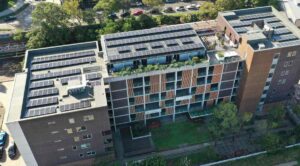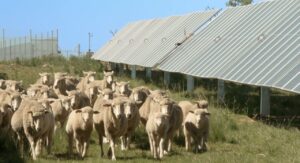New Energy Solar, the biggest listed solar investor in Australia, is to be wound up after agreeing to sell its remaining portfolio of 14 US solar farms to a company run by US investment bank giant Goldman Sachs.
The $US244.5 million ($A352 million) deal follows the $288 million sale last year of its two Australian solar farms – decisions driven by the board’s frustration that stock market investors had failed to properly value the company.
The latest deal will result in a total capital return of around 98c a share, around 25 per cent more than its recent trading price, and its delisting and winding up will remove one of the last opportunities for small investors to gain exposure to the green energy transition in Australia.
Almost all of Australia’s big listed renewable energy developers – Infigen Energy, Tilt Renewables, Windlab and now New Energy Solar, struggled to get traction in the stock market, which in turn impinged on their ability to raise equity and finance for their projects.
All their assets are now in private hands, or in the case of Infigen, one of the largest energy companies in the world, the Spanish based Iberdrola.
And Genex Power, which owns two operating solar farms and is building the country’s first new pumped hydro storage project in nearly four decades, and is also building a big battery in Queensland, is destined to be taken private by a consortium led by Atlassian co-founder Scott Farquhar.
Indeed, Australia’s richest men – Andrew Forrest, Farquhar and his Atlassian co-founder Mike Cannon-Brookes – are taking leading roles in funding the green energy transition, but through private companies.
Forrest and Cannon-Brookes are behind the massive Sun Cable project, which plans to build the world’s biggest solar farm and battery and supply power to Singapore, while Forrest also now owns Windlab and its development portfolio.
Farquhar and his wife, Kim Jackson, along with a private fund Stonehead founded by some ex Macquarie bankers, could secure Genex for less than its trading price of early last year, despite its windfall solar returns and the promise of its fully funded new storage projects which will come on line in coming years.
Green energy transition investment options for small investors are now restricted to more speculative technology stocks, such as flow battery maker Redflow, wave energy hopeful Carnegie, thermal storage developer 1414 Degrees, and a range of mining stocks looking to minerals such as lithium, vanadium, nickel and copper.
The deal struck between New Energy Solar and MN8, the Goldman Sachs company, was struck pretty much in line with the state net asset value of the US portfolio – a value that stock market investors struggled to recognise.
The company will deliver an initial return of capital of $A0.82 per share, and will deliver a further return or returns of capital estimated to total between $A0.13 and A$0.163 per share when it is wound up, likely towards the end of 2023.
New Energy Solar tried everything it could to attract investor interest – implementing a series of strategic initiatives, share buybacks, the sale of its Australian solar farms Manildra and Beryl to Thai company Banpu for $288.5 million, and a return of capital.
“Despite these measures, the trading discount persisted,” it noted, and in February this year the board decided to seek bidders for its US solar assets.
The sale is subject to shareholder approval, which will take place on September 26.










